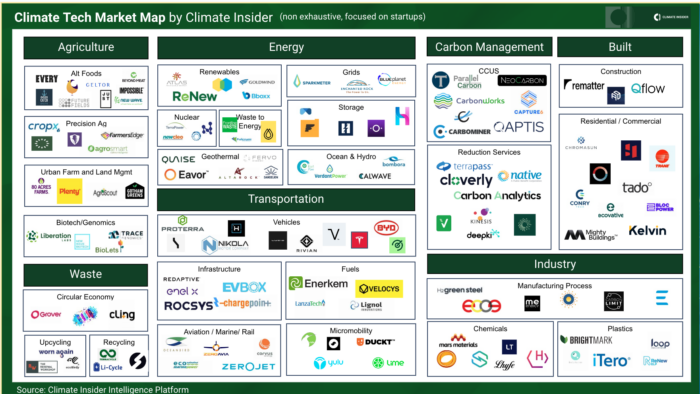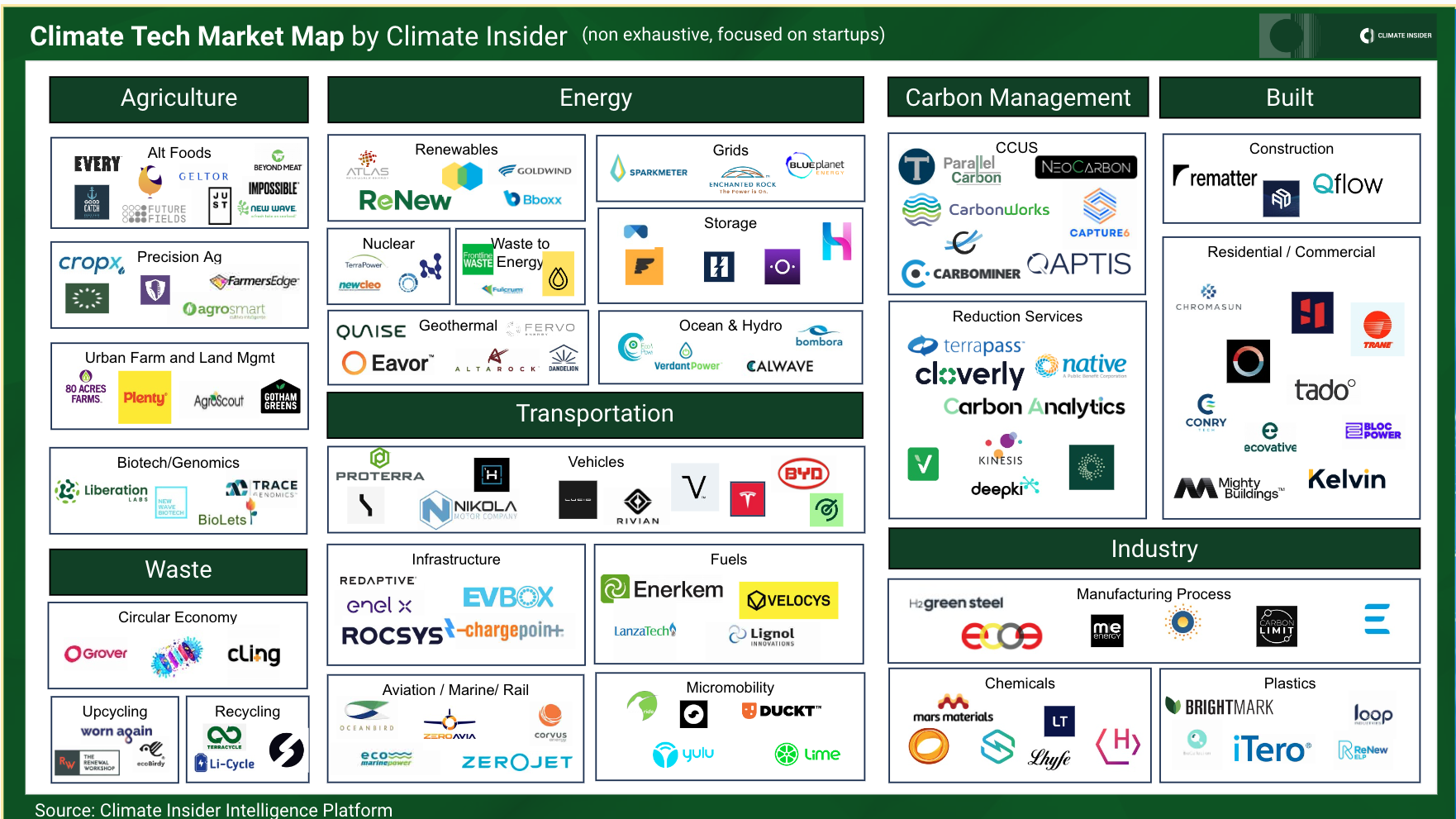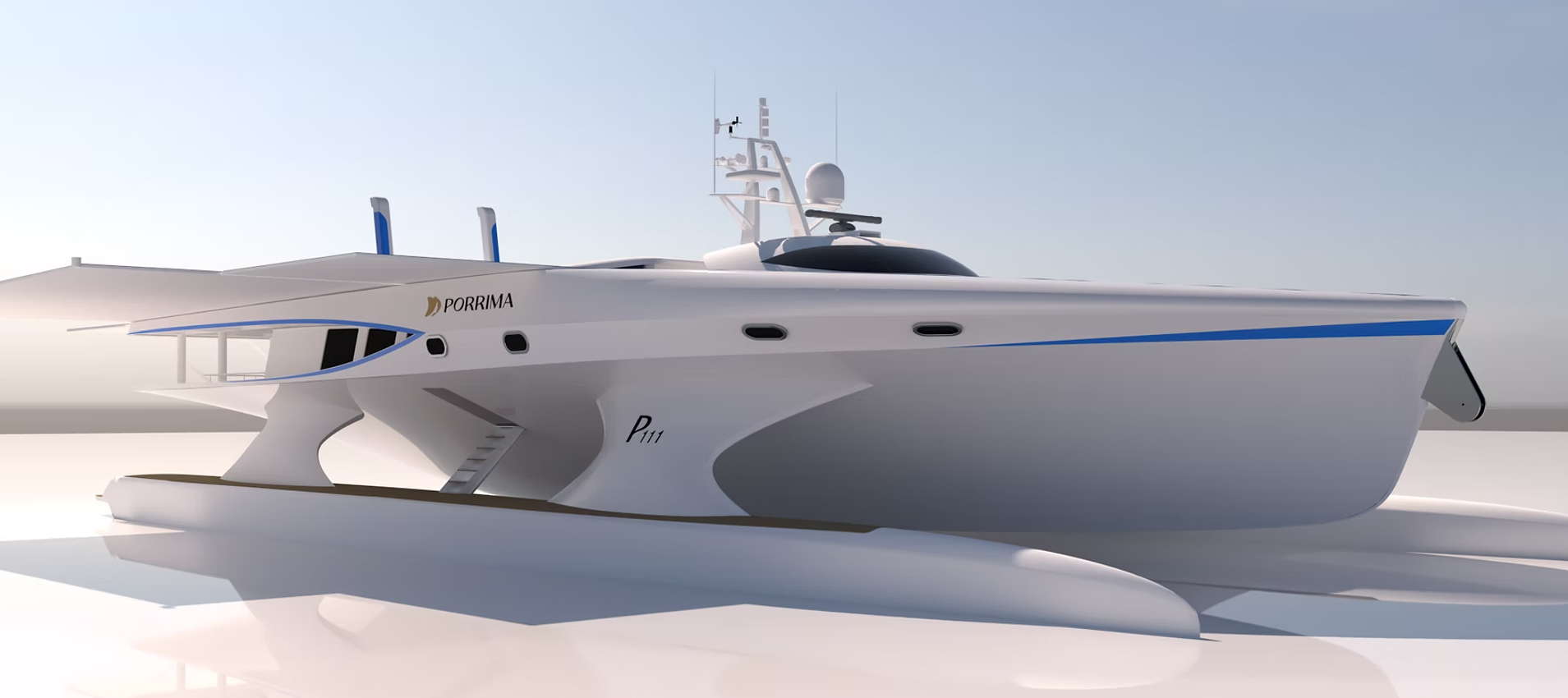Climate tech looks to address climate change challenges and these solutions span nearly all aspects of human activity. The Complexity of Creating a Climate Tech Market Map:
Putting together a taxonomy and climate tech market map is complex due to the characteristics of the climate tech industry, such as:
- Diverse categories: energy, agriculture, transportation, manufacturing, etc.
- Rapid innovation and evolving technologies
- Interdisciplinary in nature, for example, electric vehicle production involves multiple sectors.
- Global reach with companies developing projects all over the world.
The Taxonomy of the Climate Tech Industry
To best explain, understand and organize the space, we have created seven segments each with multiple subsegments. They are:
- Food and Agriculture which includes the subsegments of biotech and genomics, precision agriculture, alternative foods, and vertical and urban farming
- The Built Environment for construction and residential and commercial buildings
- Energy that encompasses renewables, grids, nuclear energy, geothermal, energy storage, waste-to-energy, oceans and hydro..
- Transportation including electric vehicles, aviation/marine/rail, fuels, micromobility and infrastructure
- Carbon Management which encompasses carbon capture, utilization, storage, and carbon management services.
- Waste and its three subsegments circular economy, upcycling and recycling.
- Industry that includes manufacturing, plastics and chemicals.
Introduction
Climate tech is dedicated to addressing the urgent challenges of climate change. And since climate change represents such a large-scale and global issue, these technologies span all aspects of human activity. From transforming agriculture practices, to reimagining the built environment, to revolutionizing transportation, climate tech development has emerged as one of the most important and pervasive responses to these climate-related problems.

Navigating the ecosystem of technological advances requires a clear understanding of market trends, key players and global perspectives. In the rapidly evolving landscape of climate tech startups, market maps can be important tools to better organize and understand the complexities of the space.
In this introduction, we will explore the intricacies and challenges of creating a climate tech market map for the startup industry. We highlight our methodology and delve into the key categories that were included in our taxonomy.
Read also: Top 11 Climate Tech Companies in 2024
The Complexity of Creating a Climate Tech Market Map
Developing a climate tech market map for the startup industry is no simple task due to the multifaceted nature of the sector. Several factors contribute to this complexity:
- Diverse Categories: Climate tech encompasses a wide array of categories, each with its unique set of challenges and opportunities. These categories span across energy, agriculture, transportation, manufacturing, and more. Understanding the nuances within each category is crucial for developing a climate tech market map.
- Rapid Innovation: Climate tech is characterized by rapid innovation and ever-evolving technologies. Startups in this field often leverage cutting-edge science and engineering to develop solutions, making it challenging to keep up with the latest developments.
- Interdisciplinary Nature: Climate tech solutions frequently blur the lines between traditional industries. For instance, the development of electric vehicles involves expertise from the automotive, battery technology, and renewable energy sectors. For their effective use, EVs also require the supporting infrastructure, such as charging stations, to be developed simultaneously. As a result, identifying the key players and connections is not always obvious, nor linear.
- Global Reach: Climate change is a global challenge, and climate tech startups operate on an international scale. This means that market mapping must consider global trends, regulations, and regional variations in adoption.
Methodology for Creating a Climate Tech Market Map
Creating a climate tech market map for the startup industry requires a systematic approach to capture the diverse landscape accurately. The steps include:
- Segmentation: We began by categorizing the climate tech industry into key segments like energy generation, energy storage, transportation, agriculture, etc. This segmentation helps in breaking down the complexity into manageable components. The segments were adjusted to ensure most technologies are captured, while limiting how many technologies overlap into multiple categories.
- Market Research: We then conducted market research to identify startups, established companies, and research institutions involved in each segment. Data sources included industry reports, news articles, and investment databases. This research will be ongoing and will be used to update and revise our maps to ensure we are organizing the industry appropriately and accurately.
A Snippet in Time – A Climate Tech Market Map of Startups

The startups included are just a few examples for each segment, which have hundreds or thousands of companies. These companies presented on the map have made it on industry lists of startups to watch for in 2023 or highlighted in a recent review.
Ongoing process
As stated above, this process is not a one-and-done activity. We monitor the markets and conduct network analysis daily and use this information to update the taxonomy regularly. In addition, our daily work includes:
- Technology Scanning: We keep abreast of emerging technologies by monitoring patent filings, academic publications, and startup funding rounds. This allows for a forward-looking perspective on the market.
- Regulatory Analysis: We consider the impact of government policies and regulations on the climate tech industry, as these factors can significantly shape the market dynamics.
Key Segment and Sub-Segments in Climate Tech Market Map
In our first iteration of the climate tech market map, the following segments and sub-segments were deemed to be the most important in the climate tech sector.
Food and Agriculture
Climate tech startups in food and agriculture focus on sustainable farming practices, precision agriculture, and the reduction of greenhouse gas emissions. Technologies such as AI-driven crop management, soil health monitoring, and carbon sequestration play vital roles in this category. Subsegments include:
- Biotech and Genomics: Advancements in biotechnology and genomics are driving innovations in crop breeding, pest management, and disease resistance, leading to more sustainable and resilient agricultural practices.
- Precision Agriculture: Precision agriculture employs technologies such as drones, sensors, and data analytics to optimize resource use, improve crop yields, and reduce environmental impacts.
- Alternative foods: Companies are developing foods such as plant-based proteins and lab-grown meats.
- Vertical and Urban Farming & Land Management: Hydroponics, aeroponics and aquaponics are a few of the emerging technologies that create innovative ways to grow food that requires less space and less energy.
The Built Environment
In the climate tech industry, the “Built Environment” segment focuses on enhancing the sustainability and environmental friendliness of buildings and infrastructure. This encompasses innovations in design, materials, and technologies that reduce the environmental impact of construction and improve the energy efficiency and sustainability of residential and commercial spaces. The goal is to create a built environment that minimizes carbon emissions, conserves resources, and promotes overall environmental health.
The subsegments include:
- Construction: deals with sustainable practices and technologies in the construction of new buildings and infrastructure. For cleantech startups technologies include:
- Green Building Materials: Startups may develop or utilize sustainable, low-impact materials for construction, reducing the carbon footprint of buildings.
- Energy-Efficient Construction Techniques: Innovations in construction methods that minimize energy use and reduce waste during the building process.
- Smart Construction Technology: Use of IoT, AI, and other digital tools to optimize construction processes, enhance resource efficiency, and reduce environmental impact.
- Residential: Focuses on making homes more energy-efficient, sustainable, and environmentally friendly. Technologies may include:
- Home Energy Management Systems: Technologies that allow homeowners to monitor and reduce their energy consumption.
- Sustainable Home Design: Startups may offer design services or solutions that emphasize energy efficiency, such as passive solar design or green roofing.
- Renewable Energy Integration: Solutions for integrating renewable energy sources, like solar panels or geothermal systems, into residential properties.
- Commercial: involves the application of sustainable practices and technologies in commercial buildings and spaces, including offices, retail, and other business premises. Relevant climate technologies are:
- Energy Management: Advanced systems for managing and reducing energy consumption in commercial spaces.
- Green Retrofitting: Upgrading existing commercial buildings with energy-efficient systems, sustainable materials, and other eco-friendly improvements.
- Sustainable Architecture and Design: Innovations in commercial building design that incorporate sustainable materials, energy-efficient systems, and environmentally friendly practices.
- High-Efficiency HVAC and Lighting Systems: Systems designed specifically for the unique needs of commercial buildings.
- Cross-cutting Solutions:
- Urban Planning and Design: Designing cities and communities in a way that reduces the need for transportation, maximizes green spaces, and promotes sustainable living
- Digital Twins and Building Information Modeling (BIM): Using digital replicas of physical buildings to optimize design, construction, and operation.
- Retrofitting: Upgrading existing buildings to make them more energy-efficient and sustainable.
Energy
The energy sector within climate tech is diverse, reflecting a broad spectrum of technologies and solutions aimed at reducing carbon emissions and advancing sustainability. This diversity is especially evident when considering the following subcategories:
- Renewable Energy: This includes solar, wind, and hydropower, among others. The development and deployment of renewable energy technologies are critical in transitioning away from fossil fuels.
- Grids: Smart grids and grid management technologies are essential for integrating renewable energy sources efficiently and ensuring a stable energy supply.
- Nuclear Energy: Despite its contentious nature, nuclear energy remains a low-carbon option for power generation.
- Advanced nuclear technologies are also being explored. Growing investments and development in small modular reactors (SMRs) are moving the timelines closer for their deployment.
- Very small SMRs (vSMRs) could be used for industrial applications such as at a mine site.
- In this section we also include the emerging developments in fusion technology.
- Geothermal Energy: Leveraging the earth’s heat as a source of clean energy has the potential to reduce reliance on fossil fuels.
- Energy Storage: Energy storage solutions, such as advanced batteries and pumped hydro, play a crucial role in balancing supply and demand in renewable-heavy grids.
- Ocean and Hydro Energy: Hydroelectricity is the production of power using a dam or other diversion structure. Technologies like tidal and wave energy harness the power of the ocean, offering another avenue for clean energy generation. This area of energy production is diverse in terms of maturity of the technologies. Hydroelectricity power generation is relatively mature while power from waves on a large scale, is a more recent development.
The diverse array of energy technologies demonstrates the complexity of this sector, with varying deployment challenges and geographical considerations.
Transportation
Transportation encompasses electric vehicles (EVs), alternative fuels, and mobility solutions that aim to reduce the carbon footprint of transportation. EV startups, in particular, have gained significant attention for their role in decarbonizing the automotive industry.
The transportation sector is another multifaceted arena within climate tech, covering various modes of transportation and related infrastructure needs:
- Fuels: Transitioning to cleaner fuels, such as hydrogen and advanced biofuels, is a key focus area.
- Vehicles: EVs, hydrogen-powered vehicles, and biofuel adoption vary by region and mode of transport.
- Infrastructure: Developing charging infrastructure for electric vehicles (EVs) and building high-speed rail networks are crucial to promoting sustainable mobility.
- Micromobility: Beyond traditional cars, micromobility solutions like e-scooters and e-bikes are becoming popular for short trips, reducing the need for personal vehicles.
- Aviation, Marine and Rail: Sustainable aviation fuels and electric aircraft development are emerging as potential solutions to reduce emissions in the aviation industry. Clean technologies for ships and railways are essential for reducing emissions in these sectors, given their reliance on conventional fossil fuels.
Carbon Management
In climate tech industry, the segment of Carbon Management is pivotal. It encompasses technologies, services, and strategies aimed at reducing atmospheric carbon dioxide (CO2) levels, a major contributor to global warming. This segment is crucial for startups focusing on mitigating climate change by addressing carbon emissions through various innovative approaches. The subsegments include:
- Carbon capture utilization and storage (CCUS) refers to a set of technologies that capture CO2 emissions from sources like power plants and industrial processes, or directly from the atmosphere. The captured CO2 is then either used for industrial applications (utilization) or permanently stored underground (storage).
- Capture Technologies: Startups in this area develop advanced materials and processes for efficient CO2 capture, such as solvent-based capture, membrane technology, and direct air capture systems.
- Utilization: Some startups focus on converting captured CO2 into useful products like synthetic fuels, chemicals, or building materials, thereby creating a value-added proposition.
- Storage: This involves technologies for safely storing captured CO2 in geological formations. Startups may innovate in monitoring and verification technologies to ensure the safe and permanent storage of CO2.
- Carbon Services: Encompass a range of services that help businesses and organizations measure, manage, reduce, and offset their carbon emissions. This subsegment is diverse, including carbon accounting and analytics, monitoring, and participation in carbon markets and offsets.
- Carbon Accounting and Analytics: Startups here provide software and platforms for accurately measuring and tracking carbon emissions, helping businesses understand and manage their carbon footprint.
- Carbon Monitoring: This involves technologies for real-time monitoring of carbon emissions, often using sensors, satellite imagery, and AI-driven analytics.
- Carbon Markets and Offsets: These startups facilitate the buying and selling of carbon credits, enabling companies to offset their emissions by investing in environmental projects like reforestation or renewable energy. They might also provide platforms for transparent trading and tracking of carbon credits.
Additional technologies and services that fall into this subsegment are:
- Carbon Footprint Assessment Tools: Enable businesses and individuals to assess their carbon footprint, which is the total amount of greenhouse gases produced directly and indirectly by their activities.Startups may offer online calculators, software, or consulting services to help clients measure their carbon footprint, providing a baseline for reduction strategies.
- Life Cycle Assessment (LCA) Software: Evaluates the environmental impact of a product or service throughout its entire life cycle, from raw material extraction to disposal or recycling. Startups specializing in LCA software provide detailed insights into the carbon impact of products, helping companies make more sustainable choices in design, materials, and supply chain management.
- Energy Efficiency Analysis and Optimization: This involves assessing and optimizing energy use to reduce carbon emissions. It includes energy audits, monitoring, and implementation of energy-saving measures. Startups may provide IoT-based monitoring systems, AI-driven energy optimization algorithms, and consultancy services to enhance energy efficiency in various sectors.
- Sustainable Supply Chain Management: This service focuses on reducing carbon emissions across the supply chain, from sourcing raw materials to manufacturing and distribution.
- Climate Risk Assessment and Adaptation Planning: These services help businesses and governments understand and prepare for the risks posed by climate change, including the impact on carbon emissions. Startups might offer analytical tools and consulting services to assess climate risks and develop adaptation strategies.
Waste
The waste sector in climate tech emphasizes circular economy principles, upcycling, and recycling to minimize waste generation and maximize resource efficiency. Innovations in waste management and recycling technologies aim to reduce the environmental impact of waste disposal.
- Circular Economy: Involves creating closed-loop systems where resources are reused, repaired, refurbished, and recycled for as long as possible. Startups in this segment develop innovative business models and technologies that facilitate the transition from linear to circular.
- Upcycling: Startups focusing on upcycling innovate in converting waste materials into new products or energy, often adding value through creative design or technological processes. This segment is crucial for reducing waste going to landfills and for creating value-added products from materials that would otherwise be discarded.esource use, thereby reducing waste and conserving resources.
- Recycling: These startups specialize in developing more efficient and effective methods of recycling various materials, from plastics and metals to electronics and organic waste. This segment plays a vital role in reducing the need for extracting new raw materials, thus saving energy, reducing greenhouse gas emissions, and minimizing resource depletion.
There are obvious overlaps between each of these sub-segments and companies can be often be placed in all three of them. The waste segment is also another example that the categories are potentially relevant and applicable to all the other segments listed here. In particular, the circular economy principles, as discussed below, have application across the map.
Industry
For this segment, we focus on the manufacturing processes of key sectors.
- Cement and steel are two of the most widely used construction materials globally with significant GHG emission. Therefore, companies are searching for new approaches. Technology integration is possible throughout production process. For steel producers, replacing fossil fuels inputs with hydrogen is one of the primary developments. Both cement and steel processes can also integrate carbon capture and storage technologies.
- Chemicals and plastics clearly show the dual nature of some industries in lowering emissions and meeting climate-related goals. The duality is that these industries can be used to lower emissions in other sector, while their own production processes can be improved to lower their carbon footprint.
- Chemicals as inputs: The chemical industry produces advanced materials that can make products lighter and more energy-efficient. For example, lightweight plastics and composites in vehicles can reduce fuel consumption and, therefore, emissions. Chemicals are critical for producing photovoltaic solar cells, wind turbine blades, and batteries for energy storage. Chemicals play a role in the capture of CO2 from industrial emissions. Amine-based solvents, for example, are commonly used to capture CO2 from flue gases in CCS processes. Chemical processes can also convert biomass or waste materials into biofuels or produce hydrogen for fuel cells.
- There can also be changes to how chemicals themselves are manufactured. The electrification of processes is one of the key features of most countries’ net zero policies. Switching from fossil fuel-based energy to renewable electricity for chemical production can drastically reduce emissions.
- It should also be noted that electrification, process intensification and energy efficiency can be applied to most industries and segments discussed here. For example, many stages of a manufacturing process could be electrified – the goal then is to ensure that the electricity produced comes from renewable energy sources.
Emerging Technologies that Cross Multiple Segments
- Hydrogen: Hydrogen is emerging as a versatile energy carrier with applications across multiple sectors, including energy (hydrogen fuel cells), transport (hydrogen-powered vehicles, trains and airplanes), and industry (hydrogen as a feedstock, as discussed in the industrial segment). Its potential to integrate with various climate tech sectors underscores its importance. Hydrogen’s sustainable production is also a key consideration. It can be produced in multiple ways and therefore developments in production technologies must also be tracked. Electrolysis – the splitting of water to produce hydrogen – can be linked with renewable energy sources such as wind and solar – which provides a more sustainable and lower emissions source of hydrogen. Here are 5 climate tech startups innovating green hydrogen.
- Carbon Removal Technologies: In addition to carbon capture, emerging technologies for direct air capture (DAC) and enhanced weathering are gaining attention as means to remove CO2 from the atmosphere.
- Circular Economy: Expanding beyond waste management, the circular economy concept extends to product design, manufacturing, and supply chain management to minimize waste and reduce resource consumption.
What we found
Creating a climate tech market map for the startup industry involves understanding these diverse categories and their interconnections. The importance of government policies and R&D at universities and other academic intuitions in advancing these technologies must also be recognized. As climate tech continues to evolve, monitoring these sectors and their intersections will be essential for tracking progress, and fostering sustainable solutions.
Further, developing the climate tech market map has been a complex but valuable undertaking. It requires a deep understanding of the industry’s multifaceted nature and a systematic approach to capture its intricacies. By doing so, we can gain valuable insights into the transformative potential of startups in addressing the pressing challenges of climate change. It also sets us up to continue to expand on, and become better at, our market data collection, and in doing so, can more easily and more effectively see emerging trends, weak signals, and challenges and opportunities throughout the landscape.
To stay informed about the climate industry explore our latest climate news.








